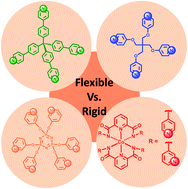Effect of pyridyl donors from organic ligands versus metalloligands on material design
Abstract
A pyridyl group, one of the most ubiquitous functionalities, has been widely used by researchers working at the forefront of framework materials such as coordination polymers (CPs) including metal–organic frameworks (MOFs) due to its versatile coordination abilities. As the coordination mode of a ligand or a linker plays a critical role in dictating the architecture of the resultant framework material, numerous pyridyl-based ligands and linkers have been developed. In recent times, various metalloligands offering appended pyridyl groups have also been developed. A metalloligand is typically rigid when compared to a flexible organic ligand and therefore a ligand versus a metalloligand is expected to afford different framework materials. Although a large number of pyridyl-based CPs including MOFs have been studied in terms of their synthesis, characterization and application, no systematic investigation on the impact of pyridyl donors emerging from an organic ligand versus a metalloligand on the material design has been attempted and the present review article is an attempt to fill this gap. This review article presents design strategies, crystal structures and topologies for various framework materials synthesized using assorted flexible as well as rigid organic ligands and rigid metalloligands offering appended pyridyl groups. The focus has been placed to delineate the effect of flexibility versus rigidity on the architectures of the resultant material.

- This article is part of the themed collection: 2021 Inorganic Chemistry Frontiers Review-type Articles


 Please wait while we load your content...
Please wait while we load your content...